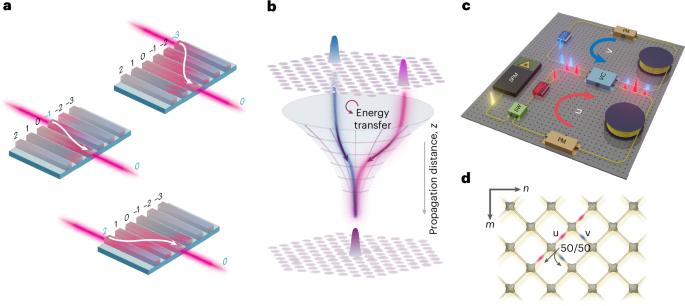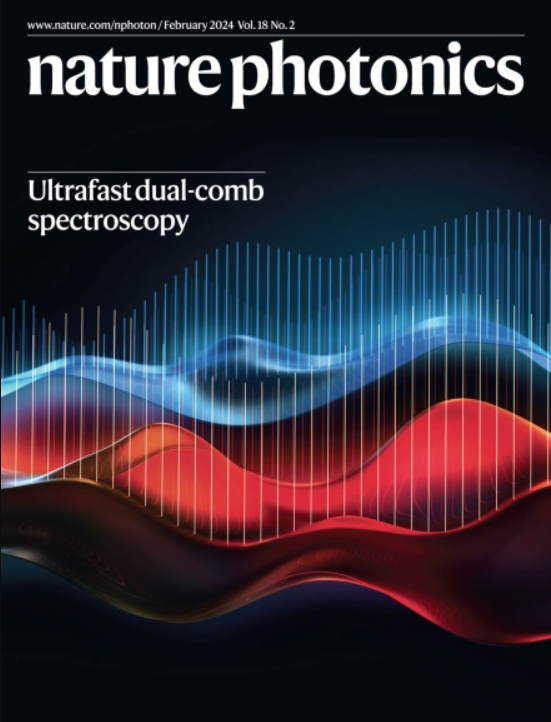Universal routing of light via optical thermodynamics
IF 32.9
1区 物理与天体物理
Q1 OPTICS
引用次数: 0
Abstract
Understanding and exploiting the dynamics of complex nonlinear systems is nowadays at the core of a broad range of scientific and technological endeavours. Within the optical domain, light evolution in a nonlinear multimode environment presents a formidable problem, as its chaotic evolution often hinders predictive insights. Recently, an optical thermodynamic framework has been put forward that, in a systematic manner, can not only predict but also harness the intricate behaviour of these systems. By deploying entropic principles, here we demonstrate a counter-intuitive optical process in which light, launched into any input port of a judiciously designed nonlinear array, universally channels into a tightly localized ground state, a response that is completely unattainable in linear conservative arrangements. This phenomenon arises from the interplay between lattice structure and the way the kinetic and nonlinear Hamiltonian components unfold, leading to two optical thermal processes: Joule–Thomson-like expansion followed by mode thermalization. Experimentally, this effect is demonstrated in properly configured nonlinear time-synthetic mesh lattices, where the optical temperature approaches near zero, causing light to condense at a single spot, regardless of the initial excitation position. The effect demonstrated here opens new avenues for applying the principles of optical thermodynamics in realizing new optical functionalities, such as all-optical beam-steering, multiplexing and nonlinear beam-shaping in high-power regimes, while also offering a greater understanding of the notable physics of light–matter interactions in multimode nonlinear systems. By exploiting an optical thermodynamic framework, researchers demonstrate universal routing of light. Specifically, light launched into any input port of a nonlinear array is universally channelled into a tightly localized ground state. The principles of optical thermodynamics demonstrated may enable new optical functionalities.

通过光学热力学实现光的通用路由
理解和开发复杂非线性系统的动力学是当今广泛的科学和技术努力的核心。在光学领域,非线性多模环境下的光演化是一个棘手的问题,因为它的混沌演化常常阻碍预测。最近,一个光学热力学框架被提出,以一种系统的方式,不仅可以预测,而且可以利用这些系统的复杂行为。通过运用熵原理,我们在这里展示了一个反直觉的光学过程,在这个过程中,光被发射到一个精心设计的非线性阵列的任何输入端口,普遍通道进入一个紧密定位的基态,这是一个在线性保守安排中完全无法实现的响应。这种现象源于晶格结构与动力学和非线性哈密顿分量展开方式之间的相互作用,导致两种光学热过程:焦耳-汤姆逊类膨胀和模式热化。在实验中,这种效应在适当配置的非线性时间合成网格晶格中得到了证明,其中光学温度接近于零,导致光在单个点上凝聚,而不管初始激发位置如何。这里展示的效应为应用光学热力学原理实现新的光学功能开辟了新的途径,例如在高功率状态下的全光光束导向,多路复用和非线性光束整形,同时也提供了对多模非线性系统中光-物质相互作用的显着物理的更好理解。通过利用光学热力学框架,研究人员展示了光的通用路径。具体地说,发射到非线性阵列的任何输入端口的光被普遍地引导到一个紧密定位的基态。所证明的光学热力学原理可能使新的光学功能成为可能。
本文章由计算机程序翻译,如有差异,请以英文原文为准。
求助全文
约1分钟内获得全文
求助全文
来源期刊

Nature Photonics
物理-光学
CiteScore
54.20
自引率
1.70%
发文量
158
审稿时长
12 months
期刊介绍:
Nature Photonics is a monthly journal dedicated to the scientific study and application of light, known as Photonics. It publishes top-quality, peer-reviewed research across all areas of light generation, manipulation, and detection.
The journal encompasses research into the fundamental properties of light and its interactions with matter, as well as the latest developments in optoelectronic devices and emerging photonics applications. Topics covered include lasers, LEDs, imaging, detectors, optoelectronic devices, quantum optics, biophotonics, optical data storage, spectroscopy, fiber optics, solar energy, displays, terahertz technology, nonlinear optics, plasmonics, nanophotonics, and X-rays.
In addition to research papers and review articles summarizing scientific findings in optoelectronics, Nature Photonics also features News and Views pieces and research highlights. It uniquely includes articles on the business aspects of the industry, such as technology commercialization and market analysis, offering a comprehensive perspective on the field.
 求助内容:
求助内容: 应助结果提醒方式:
应助结果提醒方式:


